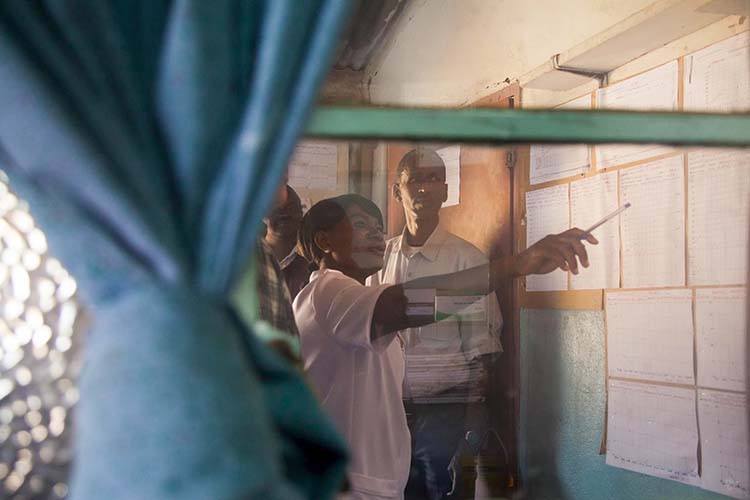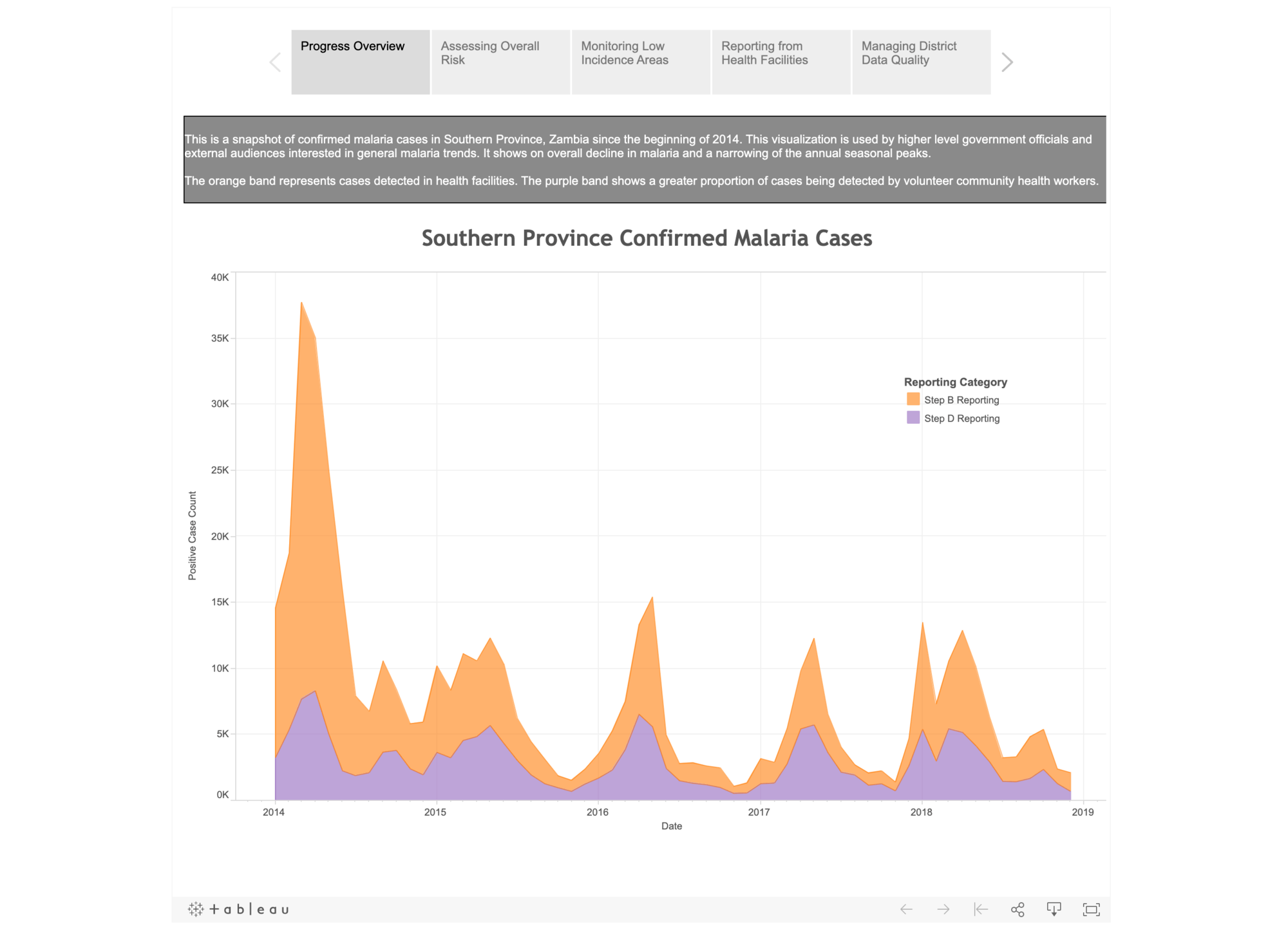Improving global health through data: Tableau Foundation looks back at 2019
Editor’s Note: As the year comes to a close, the Tableau Foundation team took the opportunity to reflect back on what we’ve learned about poverty, inequity, climate change, global health, and employee engagement. This series of blog posts shares the most critical insights we’ve gained from our partners and our programming over the past year, and we look forward to what’s to come in the next decade.
Think about some of the major health problems claiming the lives of people around the world. From malaria to malnutrition to diarrheal disease, these are conditions we have the knowledge and methods to treat. But just because solutions exist doesn’t mean they’re always accessible. At Tableau Foundation, our partners are working in the midst of these issues to close the gaps between treatments and those most in need of them. They have taught us that health is not just about innovating on cures—it’s also about using data to understand where those solutions can have the greatest impact, and making sure they reach the people affected.
Over the past year, our partners at PATH, Splash, and Operation Fistula, have reminded us of the value of data-informed connections in the healthcare space: connections between treatments and people in need, between organizations working on similar issues, and between public-private-NGO partnerships as well. A good health system is a well-networked one. In this blog, we dive deeper into this, and other, powerful insights our partners have shared with us over the last year:

Health workers in Zambia analyze malaria data (photo courtesy of PATH)
1. Data needs to back up every solution
One of our partners, Splash, works on a health issue for which the solution is very well known, but poorly distributed: access to clean water and good sanitation infrastructure. Splash wants to bring quality water-filtration technology to schools and orphanages across cities in Africa and Asia, starting with the goal of reaching one million kids in Addis Ababa, Ethiopia and Kolkata, India. The technology exists, so Splash focuses on the delivery and access, making sure it gets into the hands of people who lack it—and that they have the tools and support needed to maintain the quality infrastructure.
For Splash, and for many of our partner organizations, it’s not about the technology or the innovation itself. It’s about whether or not the tools and methods reach the people it need to, and if everything ’is working optimally. “When we work in a school, say of 900 kids, we need to know if the toilets we construct are functioning, if the water stations that we build are being used, if soap is being put out each day, if the teachers are imparting the right lessons,” says Eric Stowe, executive director of Splash. “And if you take Ethiopia, where in one city we work in 500 schools, serving 500,000 kids, that’s a lot of questions that need to be asked.” Splash will use Tableau to build dashboards to track the answers to those questions from every school and orphanage in real time. Using data, they can know immediately if a school needs support to fix its water filter or if not enough soap is being distributed to all the kids. What Splash is showing us is that it’s not enough for organizations to deploy a simple solution and walk away, expecting success. Organizations need accurate, real-time data to keep them connected to their projects and the people they serve.

School kids in India test out their new water foundation (photo courtesy of Splash)
2. Recognize when you don’t need to reinvent the wheel
The way Splash is planning to use data and Tableau to answer questions about their work will help them ensure quality and accountability across all their projects. It’s also, on a larger level, about scale and replicability—and proving that their model works. They hope the work they’re doing will be supported and implemented by national and local governments at scale. “We will not get there if we’re unable to give the government clear data that shows there is a before and after, that there is increased cost efficiency, and that there are more kids going to school on more days because they’re healthier,” Stowe says.
In a sense, what Splash wants to do is hand governments an efficient and effective model they can plug into any city, in any country. With an issue as widespread as lack of access to clean water, time saved on program design and implementation results in lives saved.
What we’ve learned from our partner, PATH, a global health organization working at the intersection of technology, innovation, and global health, is that having good data around the efficacy of a program will get other governments and program leaders to pay attention.
For the past several years, PATH and Tableau Foundation have been working in partnership to eradicate malaria in Zambia. Now that PATH and Tableau Foundation have built a solid tech stack for the Visualize No Malaria program in Zambia, we’ve been able to expand and bring the ministries of health in Senegal and Ethiopia onto the same tech stack. “One of the problems in the global health sector is the proliferation of pilot projects that never scale,” says Neal Myrick, global head of the Tableau Foundation. From the way that PATH has scaled—and how Splash is hoping to similarly scale—we’ve seen the incredible value of investing in a model that works, and ensuring that as many people have access to it as possible. “We’ve been advocating for funders and program leaders to start scaling things that work versus creating brand new programs all the time,” Myrick says. “The ability to share program design and resources across organizations and geographies is a huge win.”

Year-over-year tracking of identified malaria cases across Zambia’s Southern Province. Cases are differentiated by whether they were identified in a health center (Step B) or by a Community Health Worker in the home (Step D). (Dashboard courtesy of PATH)
3. For the greatest impact, understand how health connects to other disparities
As we continue to invest in nonprofits that scale critical interventions for global health, we’ve learned that while improving health outcomes is the primary focus of the work, it’s often much broader than that. Splash, for instance, is as much about health as it is about equity. The non-profit targets its programs to the most economically-disadvantaged kids in urban areas, Stowe says, because it wants to set cities up to serve children more equally going forward. “The breakdown of hardware like sinks and toilets really limits a child’s ability to stay healthy,” Stowe says. And beyond the health impacts, the lack of good, on-site sanitation infrastructure poses “really significant barriers to a child’s education.” That, in turn, perpetuates inequitable outcomes for those children throughout their lives.
One of our other partners, Operation Fistula, is focused on drawing the link between health and gender equity. Their work focuses on ending obstetric fistula, a devastating result of complicated childbirth that occurs when a woman doesn’t have access to care options like c-sections. Fistula is preventable and curable, but the women who do not have access to treatment and care are often isolated from society, compounding the barriers to independence and success they might already face as women. Operation Fistula, like Splash, leads with health, but their work has taught us how one issue can act as a lever to challenge even larger systemic inequities.

Tracking case statistics and demographics of women receiving care for obstetric fistula in Bangladesh (Dashboard courtesy of Operation Fistula).
Our partners in the global health space have shown us how health is a complex function of many factors beyond diseases and cures. It’s about the contexts in which people live and the access they have to resources—one as simple as clean water. We know, through our partners, that data can ensure that treatments are reaching the people they need and that they’re working effectively. But good data infrastructure also enables organizations and governments to ask questions about how well those solutions are working, and to share systems and best practices across contexts. Data can weave a strong network through which governments, non-profits, and private companies can work together to stay accountable for the health of people and communities as a whole.
To learn more about our partnerships for global health, visit: https://www.tableau.com/foundation/issue-area/Global-Health
Related Stories
Subscribe to our blog
Get the latest Tableau updates in your inbox.








